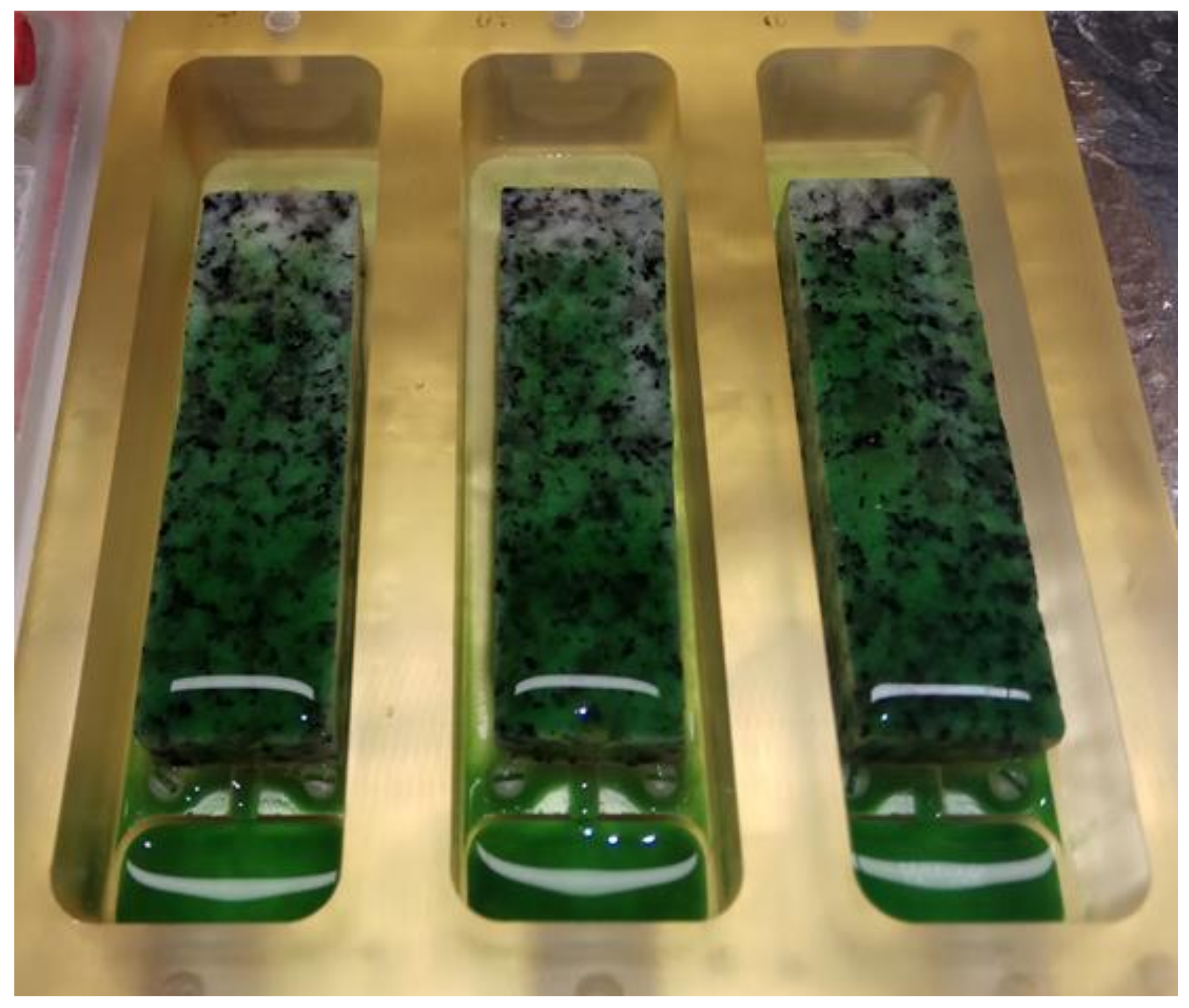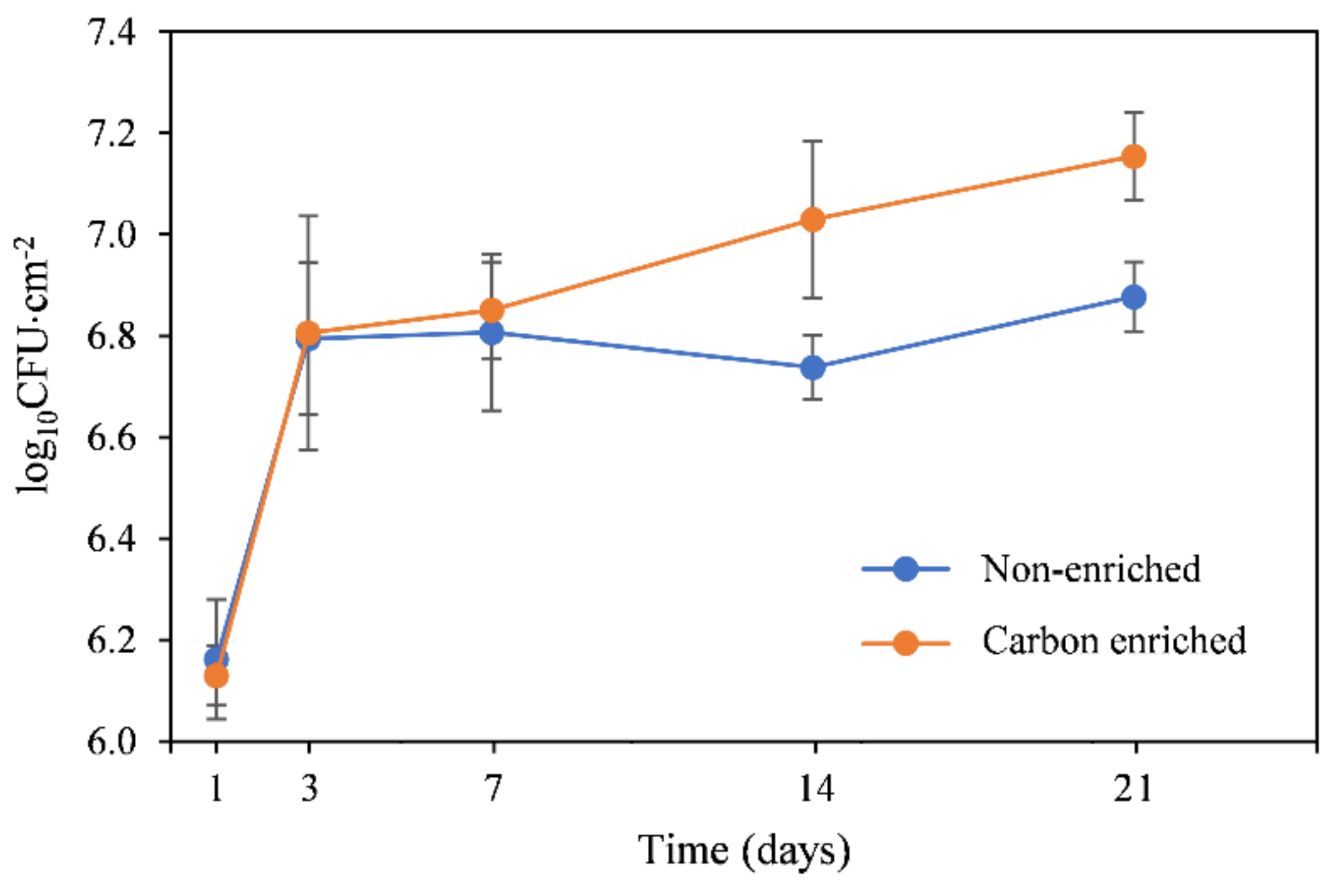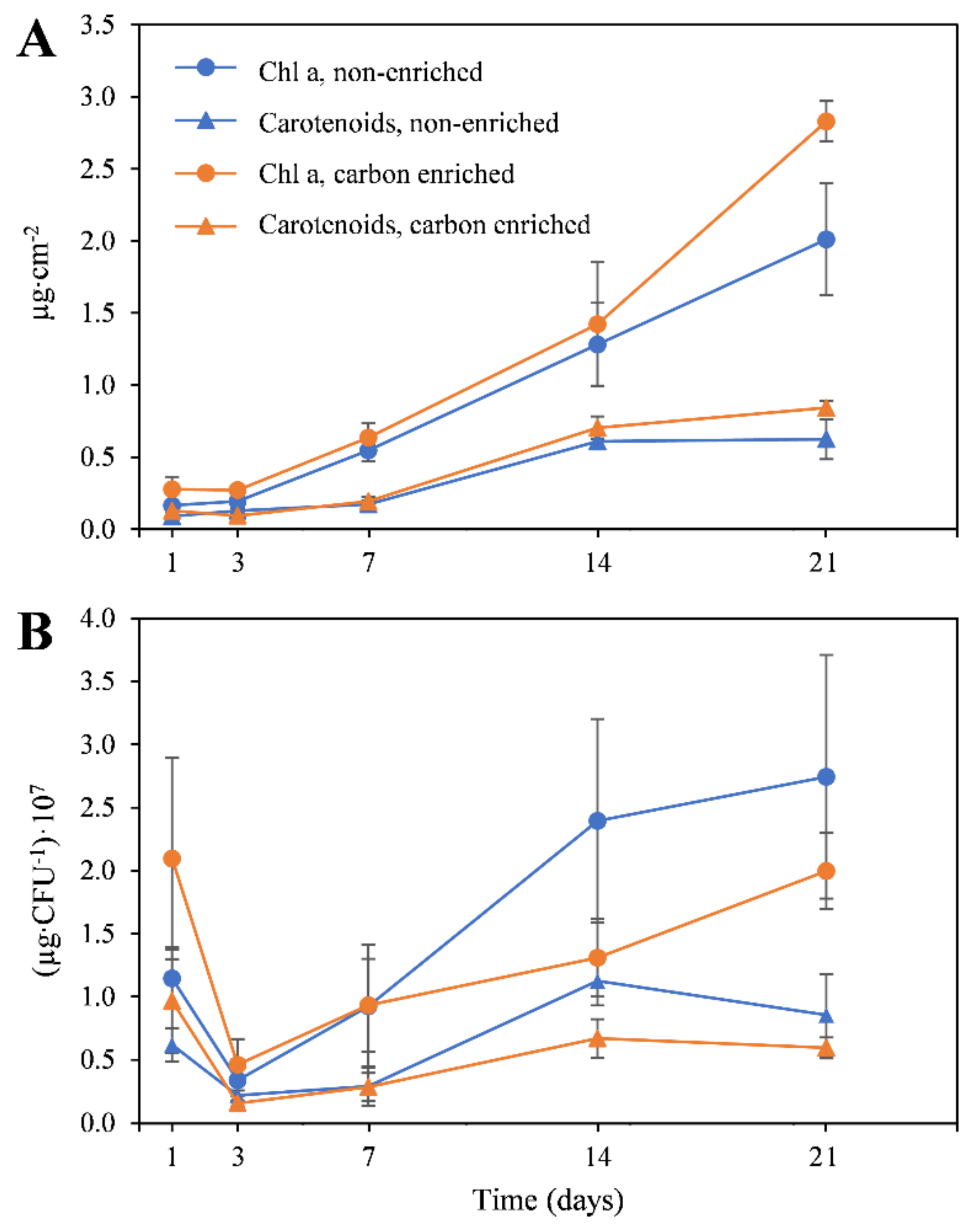Effect of Inorganic Carbon Concentration on the Development of Subaerial Phototrophic Biofilms on Granite
Abstract
1. Introduction
2. Materials and Methods
2.1. Lithotype Studied
2.2. Strain Studied and Culture Conditions
2.3. Procedure for Biofilm Formation in the Laboratory
2.4. Assessment of Biofilm Development
2.4.1. Biomass Quantification
2.4.2. Determination of Photosynthetic Pigments
2.4.3. Assessment of Oxidative Stress
2.4.4. Determination of Extracellular Polymeric Substances (EPS)
2.4.5. Statistical Analyses
2.5. Biofilm Imaging by Confocal Laser Scanning Microscopy (CLSM)
3. Results
4. Discussion
5. Conclusions
Author Contributions
Funding
Acknowledgments
Conflicts of Interest
References
- Intergovernmental Panel on Climate Change. Climate Change 2014 Mitigation of Climate Change; Cambridge University Press: New York, NY, USA, 2014.
- Wakefield, R.D.; Jones, M.S. An introduction to stone colonizing micro-organisms and biodeterioration of building stone. Q. J. Eng. Geol. 1998. [Google Scholar] [CrossRef]
- Polo, A.; Gulotta, D.; Santo, N.; Di Benedetto, C.; Fascio, U.; Toniolo, L.; Villa, F.; Cappitelli, F. Importance of subaerial biofilms and airborne microflora in the deterioration of stonework: A molecular study. Biofouling 2012, 28, 1093–1106. [Google Scholar] [CrossRef] [PubMed][Green Version]
- Giacomucci, L.; Bertoncello, R.; Salvadori, O.; Martini, I.; Favaro, M.; Villa, F.; Sorlini, C.; Cappitelli, F. Microbial Deterioration of Artistic Tiles from the Façade of the Grande Albergo Ausonia & Hungaria (Venice, Italy). Microb. Ecol. 2011, 62, 287–298. [Google Scholar] [CrossRef] [PubMed]
- Cappitelli, F.; Salvadori, O.; Albanese, D.; Villa, F.; Sorlini, C. Cyanobacteria cause black staining of the National Museum of the American Indian Building, Washington, DC, USA. Biofouling 2012, 28, 257–266. [Google Scholar] [CrossRef] [PubMed]
- Gorbushina, A.A. Life on the rocks. Environ. Microbiol. 2007, 9, 1613–1631. [Google Scholar] [CrossRef] [PubMed]
- Villa, F.; Stewart, P.S.; Klapper, I.; Jacob, J.M.; Cappitelli, F. Subaerial Biofilms on Outdoor Stone Monuments: Changing the Perspective Toward an Ecological Framework. Bioscience 2016, 66, 285–294. [Google Scholar] [CrossRef]
- Villa, F.; Vasanthakumar, A.; Mitchell, R.; Cappitelli, F. RNA-based molecular survey of biodiversity of limestone tombstone microbiota in response to atmospheric sulphur pollution. Lett. Appl. Microbiol. 2015, 60, 92–201. [Google Scholar] [CrossRef]
- Warscheid, T.; Braams, J. Biodeterioration of stone: A review. Int. Biodeterior. Biodegrad. 2000, 46, 343–368. [Google Scholar] [CrossRef]
- Gómez-Bolea, A.; Llop, E.; Ariño, X.; Saiz-Jimenez, C.; Bonazza, A.; Messina, P.; Sabbioni, C. Mapping the impact of climate change on biomass accumulation on stone. J. Cult. Herit. 2012, 13, 254–258. [Google Scholar] [CrossRef]
- Villa, F.; Cappitelli, F. The ecology of subaerial biofilms in dry and inhospitable terrestrial environments. Microorganisms 2019, 7, 380. [Google Scholar] [CrossRef]
- Korner, C. Biosphere responses to CO2 enrichment. Ecol. Appl. 2000, 10, 1590–1619. [Google Scholar] [CrossRef]
- Velu, C.; Cirés, S.; Brinkman, D.L.; Heimann, K. Effect of CO2 and metal-rich waste water on bioproduct potential of the diazotrophic freshwater cyanobacterium, Tolypothrix sp. Heliyon 5. 2019, 4, e01549. [Google Scholar] [CrossRef] [PubMed]
- Dineshbabu, G.; Uma, V.S.; Mathimani, T.; Prabaharan, D.; Uma, L. Elevated CO2 impact on growth and lipid of marine cyanobacterium Phormidium valderianum BDU 20041– towards microalgal carbon sequestration. Biocatal. Agric. Biotechnol. 2020, 25, 101606. [Google Scholar] [CrossRef]
- Schimel, D.S. Terrestrial ecosystems and the carbon cycle. Glob. Chang. Biol. 1995, 1, 77–91. [Google Scholar] [CrossRef]
- DeLucia, E.H.; Hamilton, J.G.; Naidu, S.L.; Thomas, R.B.; Andrews, J.A.; Finzi, A.; Lavine, M.; Matamala, R.; Mohan, J.E.; Hendrey, G.R.; et al. Net primary production of a forest ecosystem with experimental CO2 enrichment. Science 1999, 284, 1177–1179. [Google Scholar] [CrossRef]
- Hamilton, J.G.; DeLucia, E.H.; George, K.; Naidu, S.L.; Finzi, A.C.; Schlesinger, W.H. Forest carbon balance under elevated CO2. Oecologia 2002, 131, 250–260. [Google Scholar] [CrossRef]
- Walther, G.R. Community and ecosystem responses to recent climate change. Philos. Trans. R. Soc. B Biol. Sci. 2010, 365, 2019–2024. [Google Scholar] [CrossRef]
- Raven, J.A.; Gobler, C.J.; Hansen, P.J. Dynamic CO2 and pH levels in coastal, estuarine, and inland waters: Theoretical and observed effects on harmful algal blooms. Harm. Algae 2020, 91, 101594. [Google Scholar] [CrossRef]
- Viles, H.A.; Cutler, N.A. Global environmental change and the biology of heritage structures. Glob. Chang. Biol. 2012, 18, 2406–2418. [Google Scholar] [CrossRef]
- Gulotta, D.; Villa, F.; Cappitelli, F.; Toniolo, L. Biofilm colonization of metamorphic lithotypes of a renaissance cathedral exposed to urban atmosphere. Sci. Total Environ. 2018, 639, 1480–1490. [Google Scholar] [CrossRef]
- Sanmartín, P.; Silva, B.; Prieto, B. Effect of surface finish on roughness, color, and gloss of ornamental granites. J. Mater. Civ. Eng. 2011. [Google Scholar] [CrossRef]
- Villa, F.; Pitts, B.; Lauchnor, E.; Cappitelli, F.; Stewart, P.S. Development of a laboratory model of a phototroph-heterotroph mixed-species biofilm at the stone/air interface. Front. Microbiol. 2015, 6. [Google Scholar] [CrossRef] [PubMed]
- Rippka, R.; Deruelles, J.; Waterbury, J.B. Generic assignments, strain histories and properties of pure cultures of cyanobacteria. J. Gen. Microbiol. 1979, 111, 1–61. [Google Scholar] [CrossRef]
- Misra, B.B.; De Armas, E.; Tong, Z.; Chen, S. Metabolomic Responses of Guard Cells and Mesophyll Cells to Bicarbonate. PLoS ONE 2015, 10, e0144206. [Google Scholar] [CrossRef] [PubMed]
- Herigstad, B.; Hamilton, M.; Heersink, J. How to optimize the drop plate method for enumerating bacteria. J. Microbiol. Methods 2001, 44, 121–129. [Google Scholar] [CrossRef]
- Wellburn, A.R. The Spectral Determination of Chlorophylls a and b, as well as Total Carotenoids, Using Various Solvents with Spectrophotometers of Different Resolution. J. Plant Physiol. 1994, 144, 307–313. [Google Scholar] [CrossRef]
- Jakubowski, W.; Biliński, T.; Bartosz, G. Oxidative stress during aging of stationary cultures of the yeast Saccharomyces cerevisiae. Free Radic. Biol. Med. 2000, 28, 659–664. [Google Scholar] [CrossRef]
- Dubois, M.; Gilles, K.A.; Hamilton, J.K.; Rebers, P.A.; Smith, F. Colorimetric Method for Determination of Sugars and Related Substances. Anal. Chem. 1956, 28, 350–356. [Google Scholar] [CrossRef]
- Liu, Z.X.; Li, H.C.; Wei, Y.P.; Chu, W.Y.; Chong, Y.L.; Long, X.H.; Liu, Z.P.; Qin, S.; Shao, H.B. Signal transduction pathways in Synechocystis sp. PCC 6803 and biotechnological implications under abiotic stress. Crit. Rev. Biotechnol. 2015, 35, 269–280. [Google Scholar] [CrossRef]
- Verschoor, A.M.; Van Dijk, M.A.; Huisman, J.; Van Donk, E. Elevated CO2 concentrations affect the elemental stoichiometry and species composition of an experimental phytoplankton community. Freshw. Biol. 2013, 58, 597–611. [Google Scholar] [CrossRef]
- Verspagen, J.M.H.; Van De Waal, D.B.; Finke, J.F.; Visser, P.M.; Van Donk, E.; Huisman, J. Rising CO2 levels will intensify phytoplankton blooms in eutrophic and hypertrophic lakes. PLoS ONE 2014, 9, e0104325. [Google Scholar] [CrossRef]
- Morales, E.; Rodríguez, M.; García, D.; Loreto, C.; Marco, E. Crecimeinto, producción de pigmentos y exopolisacáridos de la cianobacteria Anabaena sp. PCC 7120 en función del pH y CO2. Interciencia 2002, 27, 373–378. [Google Scholar]
- Querijero-Palacpac, N.M.; Martinez, M.R.; Boussiba, S. Mass cultivation of the nitrogen-fixing cyanobacterium Gloeotrichia natans, indigenous to rice-fields. J. Appl. Phycol. 1990, 2, 319–325. [Google Scholar] [CrossRef]
- Prieto, B.; Vázquez-Nion, D.; Fuentes, E.; Durán-Román, A.G. Response of subaerial biofilms growing on stone-built cultural heritage to changing water regime and CO2 conditions. Int. Biodeterior. Biodegrad. 2020, 148, 104882. [Google Scholar] [CrossRef]
- Xia, J.R.; Gao, K.S. Impacts of elevated CO2 concentration on biochemical composition, carbonic anhydrase, and nitrate reductase activity of freshwater green algae. J. Integr. Plant Biol. 2005, 47, 668–675. [Google Scholar] [CrossRef]
- Chen, Y.; Xu, C.; Vaidyanathan, S. Influence of gas management on biochemical conversion of CO2 by microalgae for biofuel production. Appl. Energy 2020, 261. [Google Scholar] [CrossRef]
- Gordillo, F.J.L.; Jiménez, C.; Figueroa, F.L.; Niell, F.X. Effects of increased atmospheric CO2 and n supply on photosynthesis, growth and cell composition of the cyanobacterium Spirulina platensis (Arthrospira). J. Appl. Phycol. 1998, 10, 461–469. [Google Scholar] [CrossRef]
- Prieto, B.; Silva, B.; Aira, N.; Álvarez, L. Toward a definition of a bioreceptivity index for granitic rocks: Perception of the change in appearance of the rock. Int. Biodeterior. Biodegrad. 2006, 58, 150–154. [Google Scholar] [CrossRef]
- Vázquez-Nion, D.; Sanmartín, P.; Silva, B.; Prieto, B. Reliability of color measurements for monitoring pigment content in a biofilm-forming cyanobacterium. Int. Biodeterior. Biodegrad. 2013, 84, 220–226. [Google Scholar] [CrossRef]
- Sanmartín, P.; Vázquez-Nion, D.; Silva, B.; Prieto, B. Spectrophotometric color measurement for early detection and monitoring of greening on granite buildings. Biofouling 2012, 28, 329–338. [Google Scholar] [CrossRef]
- Graziani, L.; Quagliarini, E. On the Modelling of Algal Biofouling Growth on Nano-TiO2 Coated and Uncoated Limestones and Sandstones. Coatings 2018, 8, 54. [Google Scholar] [CrossRef]
- Barreiro, P.; Andreotti, A.; Colombini, M.P.; González, P.; Pozo-Antonio, J.S. Influence of the Laser Wavelength on Harmful Effects on Granite Due to Biofilm Removal. Coatings 2020, 10, 196. [Google Scholar] [CrossRef]
- Genova, C.; Fuentes, E.; Sanmartín, P.; Favero, G.; Prieto, B. Phytochemical Compounds as Cleaning Agents on Granite Colonized by Phototrophic Subaerial Biofilms. Coatings 2020, 10, 295. [Google Scholar] [CrossRef]
- Vázquez-Nion, D.; Silva, B.; Prieto, B. Bioreceptivity index for granitic rocks used as construction material. Sci. Total Environ. 2018. [Google Scholar] [CrossRef] [PubMed]
- De Philippis, R.; Sili, C.; Paperi, R.; Vincenzini, M. Exopolysaccharide-producing cyanobacteria and their possible exploitation: A review. J. Appl. Phycol. 2001, 13, 293–299. [Google Scholar] [CrossRef]
- Pereira, S.; Micheletti, E.; Zille, A.; Santos, A.; Moradas-Ferreira, P.; Tamagnini, P.; De Philippis, R. Using extracellular polymeric substances (EPS)-producing cyanobacteria for the bioremediation of heavy metals: Do cations compete for the EPS functional groups and also accumulate inside the cell? Microbiology 2011, 157, 451–458. [Google Scholar] [CrossRef] [PubMed]
- Cheng, Y.S.; Labavitch, J.M.; Vandergheynst, J.S. Elevated CO2 concentration impacts cell wall polysaccharide composition of green microalgae of the genus Chlorella. Lett. Appl. Microbiol. 2015, 60, 1–7. [Google Scholar] [CrossRef]
- Otero, A.; Vincenzini, M. Nostoc (Cyanophyceae) goes nude: Extracellular polysaccharides serve as a sink for reducing power under unbalanced C/N metabolism. J. Phycol. 2004, 40, 74–81. [Google Scholar] [CrossRef]
- De Philippis, R.; Vincenzini, M. Exocellular polysaccharides from cyanobacteria and their possible applications. Fems Microbiol. Rev. 1998, 22, 151–175. [Google Scholar] [CrossRef]
- Vázquez-Nion, D.; Silva, B.; Troiano, F.; Prieto, B. Laboratory grown subaerial biofilms on granite: Application to the study of bioreceptivity. Biofouling 2017, 33, 24–35. [Google Scholar] [CrossRef]
- Vázquez-Nion, D.; Silva, B.; Prieto, B. Influence of the properties of granitic rocks on their bioreceptivity to subaerial phototrophic biofilms. Sci. Total Environ. 2018, 33, 24–35. [Google Scholar] [CrossRef]
- Moghimifam, R.; Niknam, V.; Ebrahimzadeh, H.; Hejazi, M.A. The influence of different CO2 concentrations on the biochemical and molecular response of two isolates of Dunaliella sp. (ABRIINW-CH2 and ABRIINW-SH33). J. Appl. Phycol. 2020, 32, 175–187. [Google Scholar] [CrossRef]
- Han, P.P.; Shen, S.G.; Guo, R.J.; Zhao, D.X.; Lin, Y.H.; Jia, S.R.; Yan, R.R.; Wu, Y.K. ROS Is a Factor Regulating the Increased Polysaccharide Production by Light Quality in the Edible Cyanobacterium Nostoc flagelliforme. J. Agric. Food Chem. 2019, 67, 2235–2244. [Google Scholar] [CrossRef] [PubMed]






| Variable\Factor | Time | CO2 | Time × CO2 |
|---|---|---|---|
| CFU·cm−2 | <0.001 (F = 41.3) | 0.027 (F = 5.7) | 0.149 (F = 1.9) |
| Chl a µg·cm−2 | <0.001 (F = 113.1) | 0.005 (F = 10.0) | 0.031 (F = 3.3) |
| Chl a µg·CFU−1 | <0.001 (F = 12.5) | 0.457 (F = 0.6) | 0.032 (F = 3.3) |
| Carotenoids µg·cm−2 | <0.001 (F = 174.0) | 0.004 (F = 10.7) | 0.012 (F = 4.3) |
| Carotenoids µg·CFU−1 | <0.001 (F = 15.0) | 0.247 (F = 1.4) | 0.029 (F = 3.4) |
| ROS rel. units·CFU−1 | 0.300 (F = 1.3) | 0.071 (F = 3.6) | 0.244 (F = 1.5) |
| EPS µg carbohydrate·cm−2 | <0.001 (F = 14.5) | 0.099 (F = 3.0) | 0.070 (F = 2.6) |
| EPS µg carbohydrate·CFU−1 | <0.001 (F = 10.0) | 0.203 (F = 1.7) | 0.565 (F = 0.8) |
Publisher’s Note: MDPI stays neutral with regard to jurisdictional claims in published maps and institutional affiliations. |
© 2020 by the authors. Licensee MDPI, Basel, Switzerland. This article is an open access article distributed under the terms and conditions of the Creative Commons Attribution (CC BY) license (http://creativecommons.org/licenses/by/4.0/).
Share and Cite
Vázquez-Nion, D.; Fuentes, E.; Prieto, B. Effect of Inorganic Carbon Concentration on the Development of Subaerial Phototrophic Biofilms on Granite. Coatings 2020, 10, 1049. https://doi.org/10.3390/coatings10111049
Vázquez-Nion D, Fuentes E, Prieto B. Effect of Inorganic Carbon Concentration on the Development of Subaerial Phototrophic Biofilms on Granite. Coatings. 2020; 10(11):1049. https://doi.org/10.3390/coatings10111049
Chicago/Turabian StyleVázquez-Nion, Daniel, Elsa Fuentes, and Beatriz Prieto. 2020. "Effect of Inorganic Carbon Concentration on the Development of Subaerial Phototrophic Biofilms on Granite" Coatings 10, no. 11: 1049. https://doi.org/10.3390/coatings10111049
APA StyleVázquez-Nion, D., Fuentes, E., & Prieto, B. (2020). Effect of Inorganic Carbon Concentration on the Development of Subaerial Phototrophic Biofilms on Granite. Coatings, 10(11), 1049. https://doi.org/10.3390/coatings10111049





